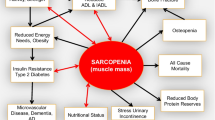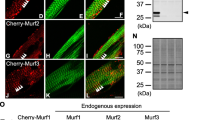Summary
Four rabbit muscles (i.e. semimembranosus proprius, psoas major, biceps femoris and longissimus lumborum), differing in their fibre type composition in the adult, were investigated during postnatal development. Muscle samples were taken at 1, 7, 14, 21, 28, 35, 49 and 77 days of age. Complementary techniques were used to characterize myosin heavy chain (MHC) isoform transitions, i.e. SDS-PAGE, immunocytochemistry and conventional histochemistry. Good accordance was found between electrophoretic and immunocytochemical techniques. Our results show that rabbit muscles were phenotypically immature at birth. At 1 day of age, perinatal isoform represented 70–90% of the total isoform content of the muscles. Two generations of myofibres could be observed on the basis of their morphology and reaction to specific antibodies. In all muscles, primary fibres expressed slow MHC. In contrast, secondary generation of fibres never expressed slow MHC in future fast muscles, while half of them expressed slow MHC in the future slow-twitch muscle, the semimembranosus proprius. During the postnatal period, all muscles displayed a transition from embryonic to perinatal MHC isoforms, followed by a transition from perinatal to adult MHC isoforms. These transitions occured mainly during the first postnatal month. The embryonic isoform was no longer expressed after 14 days, except in longissimus where it disappeared after 28 days. On the contrary, large differences were found in the timing of disappearance of the perinatal isoform between the four muscles. The perinatal isoform disappeared between 28 and 35 days in semimembranosus proprius and 35 and 49 days in psoas and biceps femoris. Interestingly, the perinatal isoform was still present in 6% of the fibres in longissimus at 77 days, the commercial slaughter age, denoting a great delay in the maturation. Fate of each generation of fibres differed between muscles.
Similar content being viewed by others
References
AIGNERS., GOHLSCHB., HÄMÄLÄINENN., STARONR. S., UBERA., WEHRLEU. & PETTED. (1993) Fast myosin heavy chain diversity in skeletal muscles of the rabbit: heavy chain IId, not IIb predominates. Eur. J. Biochem. 211, 367–72.
BACOUF. & VIGNERONP. (1976) Evolution périnatale des voies métaboliques glycolytique et oxydative de divers types de muscles squelettiques du lapin et du poulet. Ann. Biol. Anim. Biochim. Biophys. 16, 675–86.
BRIANDM., BOISSONNETG., LAPLACE-MARIEZEV. & BRIANDY. (1993) Metabolic and contractile differenciation of rabbit muscles during growth. Int. J. Biochem. 25, 1881–7.
BROOKEM. H. & KAISERK. K. (1970) Muscle fiber types: how many and what kind? Arch. Neurol. 23, 369–79.
BUTLER-BROWNEG. S. & WHALENR. G. (1984) Myosin isozyme transition occuring during the postnatal development of the rat soleus muscle. Dev. Biol. 102, 324–34.
BUTLER-BROWNEG., HERLICOVIEZD. & WHALENR. G. (1984) Effects of hypothyroidism on myosin isozyme transitions in developing rat muscle. FEBS Lett. 166, 71–5.
DAINATJ., BRESSOTC., REBIEREA. & VIGNERONP. (1986) Ontogenesis of triiodothyronine nuclear receptors in three skeletal muscles in male and female chicks. Gen. Comp. Endocrinol. 62, 479–84.
D'ALBISA., PANTALONIC. & BECHETJ. J. (1979) An electrophoretic study of native myosin isozymes and of their subunit content. Eur. J. Biochem. 99, 261–72.
D'ALBISA., JANMOTC. & BECHETJ. J. (1986) Comparison of myosins from the masseter muscle of adult rat, mouse and guinea-pig. Eur. J. Biochem. 156, 291–6.
D'ALBISA., LENFANT-GUYOTM., JANMOTC., CHANOINEC., WEINMANJ. & GALLIENC. L. (1987) Regulation by thyroid hormones of terminal differenciation in the skeletal dorsal muscle. Dev. Biol. 123, 25–32.
D'ALBISA., COUTEAUXR., JANMOTC. & ROULETA. (1989) Specific programs of myosin expression in the postnatal development of rat muscles. Eur. J. Biochem. 183, 583–90.
D'ALBISA., CHANOINEC., JANMOTC., MIRAJ. C. & COUTEAUXR. (1990) Muscle-specific response to thyroide hormone of myosin isoform transitions during rat postnatal development. Eur. J. Biochem. 193, 155–61.
D'ALBISA., JANMOTC. & COUTEAUXR. (1991) Species and muscle type dependence of perinatal isomyosin transitions. Int. J. Dev. Biol. 35, 53–6.
D'ALBISA., GOUBELF., COUTEAUXR., JANMOTC. & MIRAJ. C. (1994) The effect of denervation on myosin isoform synthesis in rabbit slow-type and fast-type muscle during terminal differenciation. Denervation induces differenciation into slow-type muscle. Eur. J. Biochem. 223, 249–58.
DEVASKARU. P., DEVASKARS. U., SADIQH. F. & CHECHANIV. (1986) Ontogeny of plasma-free thyroxine and triodothyronine concentrations during the perinatal period and maternofoetal transfer of thyroid hormones in the rabbit. Dev. Pharmacol. Ther. 9, 115–23.
ECOB-PRINCEM., HILLM. & BROWNW. (1989) Immunocytochemical demonstration of myosin heavy chain expression in human muscle. J. Neurol Sci. 91, 71–8.
FRANCHIL. L., HILLM., BROWNW. E., MAYNEC. N., ELLIOTTL. & SALMONSS. (1990) Subcellular localization of newly incorporated myosin in rabbit fast skeletal muscle undergoing stimulation-induced type transformation. J. Muscle Res. Cell Motil. 11, 227–39.
GAMBKEB., LYONSG. E., HASELGROVEJ., KELLYA. M. & RUBINSTEINN. A. (1983) Thyroidal and neural control of myosin transitions during development of rat fast and slow muscles. FEBS Lett. 156, 335–9.
GUTHL. & SAMAHAF. J. (1970) Procedure for the histochemical demonstration of actomyosin ATPase. Exp. Neurol. 28, 365–70.
GUTHL. & SAMAHAF. J. (1972) Erroneous interpretations which may result from application of the ‘myofibrillar ATPase’ histochemical procedure to developing muscle. Exp. Neurol. 34, 465–75.
HAMALAINENN. & PETTED. (1993) The histochemical profiles of fast fiber types IIB, IID and IIA in skeletal muscles of mouse, rat and rabbit. J. Histochem. Cytochem. 41, 733–43.
HOHJ. F. Y. & YEOHG. P. S. (1979) Rabbit skeletal myyosin isoenzymes from fetal, fast-twitch and slow-twitch muscles. Nature 280, 321–2.
HOHJ. F. Y., HUGHESS., HALEP. T. & FITZSIMMONSR. B. (1988) Immunocytochemical and electrophoretic analyses of changes in myosin gene expression in cat limb fast and slow muscles during postnatal development. J. Muscle Res. Cell Motil. 9, 30–47.
HUGHESS. M., CHOM., KARSCH-MIZRACHII., TRAVISM., SILBERSTEINL., LEINWANDL. A. & BLAUH. M. (1993) Three slow myosin heavy chains sequentially expressed in developing mammalian skeletal muscle. Dev. Biol. 158, 183–99.
IZUMOS., NADAL-GINARDB. & MADHAVIV. (1986) All members of the MHC multigene family respond to thyroid hormone in a highly tissue-specific manner. Science 231, 597–600.
JAKUBIEC-PUKAA., KORDOWSKAJ., CATANIC. & CARRAROU. (1990) Myosin heavy chain isoform composition in striated muscle after denervation and selfreinnervation. Eur. J. Biochem. 193, 623–8.
JANMOTC. & D'ALBISA. (1994) Electrophoretic separation of developmental and adult rabbit skeletal muscle myosin heavy chain isoforms: example of application to muscle denervation study. FEBS Lett. 353, 13–15.
LAFRAMBOISEW. A., DAOODM. J., GUTHRIER. D., SCHIAFFINOS., MORETTIP., BROZANSKIB., ONTELLM. P., BUTLER-BROWNEG. S., WHALENR. G. & ONTELLM. (1991) Emergence of the mature myosin phenotype in the rat diaphragm muscle. Dev. Biol. 144, 1–15.
LEFAUCHEURL. & VIGNERONP. (1986) Postnatal changes in some histochemical and enzymatic characteristics of three pigs muscles. Meat Sci. 16, 199–216.
LEFAUCHEURL., EDOMF., ECOLANP. & BUTLER-BROWNEG. S. (1995) Pattern of muscle fiber type formation in the pig. Dev. Dyn. 203, 27–41.
MACHZ. (1977) Postnatal changes in the thyrotropic hormone potency of the pig and the rabbit pituitary gland. Folia Biol. 25, 328–39.
NACHLASM. M., TSOUK., DESOUZAE., CHENGC. & SELIGMANA. M. (1957) Cytochemical demonstration of succinic deshydrogenase by the use of a new p-nitrophenyl substituted ditretrazole. J. Histochem. Cytochem. 5, 420–36.
NOUGESJ. (1972) Etude de l'évolution du nombre des fibres musculaires au cours de la croissance postnatale du muscle chez le lapin. C. R. Soc. Biol. Montpellier. 166, 165–72.
NOUGESJ. (1973) Etude histologique de la croissance postnatale des muscles soleus et accessorius latissimi dorsi chez le lapin commun. Ann. Biol. Anim. Biochim. Biophys. 13, 37–50.
PICARDB., ROBELINJ., PONSF. & GEAYY. (1994) Comparison of the foetal development of fibre types in four bovine muscles. J. Muscle Res. Cell Motil. 15, 473–86.
REISERP. J., MOSSR. L., GIULANG. G. & GREASERM. L. (1985) Shortening velocity in single fibers from adult rabbit soleus muscles is correlated with myosin heavy chain composition. J. Biol. Chem. 260, 9077–80.
ROBELINJ., LACOURTA., BECHETD., FERRARAM., BRIANDY. & GEAYY. (1991) Muscle differenciation in the bovine fetus: a histological and histochemical approach. Growth Dev. Aging 55, 151–60.
ROBELINJ., PICARDB., LISTRATA., JURIEC., BARBOIRONC., PONSF. & GEAYY. (1993) Myosin expression in semitendinosus muscle during fetal development of cattle: immunocytochemical and electrophoretic analyses. Reprod. Nutr. Dev. 33, 25–41.
RUBINSTEINN. A. & KELLYA. M. (1981) Development of muscle fiber specialization in the rat hindlimb. J. Cell Biol. 90, 128–44.
SAS User's Guide (1985) Statistical Analysis System Institute. Inc., Cary, NC.
SCHIAFFINOS., GORZAL., SARTORES., SAGGINL., AUSONIS., VIANELLOM., GUNDERSENK. & LOMOT. (1989) Three myosin heavy chain isoforms in type 2 skeletal muscle fibres. J. Muscle Res. Cell Motil. 10 197–205.
STOCKDALEF. E. & MILLERJ. B. (1987) Review the cellular basis of myosin heavy chain isoform expression during development of avian skeletal musculature. Dev. Biol. 123, 1–9.
SWYNGHEDAWB. (1986) Developmental and functional adaptation of contractile proteins in cardiac and skeletal muscles. Physiol. Rev. 66, 710–71.
SYROVYI. (1977) Myosin-characteristics of the semitendinosus and extensor digitorum longus muscle of new-born and adult rabbit. Int. J. Biochem. 8, 847–8.
SYROVYI. & GUTMANNE. (1977) Differenciation of myosin in soleus and extensor digitorum longus muscle in different animals species during development. Pflügers Arch. 369, 85–9.
TALMADGER. G. & ROYR. R. (1993) Electrophoretic separation of rat skeletal muscle myosin heavy-chain isoforms. J. Appl. Physiol. 75, 2337–40.
VANHARDEVELDC. & KASSENAARA. A. H. (1978) Thyroid hormone uptake and T4 derivated T3 formation in different skeletal muscle types of normal and hyperthyroid rats. Acta Endocr. 88, 306–20.
Author information
Authors and Affiliations
Rights and permissions
About this article
Cite this article
Gondret, F., Lefaucheur, L., D'Albis, A. et al. Myosin isoform transitions in four rabbit muscles during postnatal growth. J Muscle Res Cell Motil 17, 657–667 (1996). https://doi.org/10.1007/BF00154060
Received:
Revised:
Accepted:
Issue Date:
DOI: https://doi.org/10.1007/BF00154060




